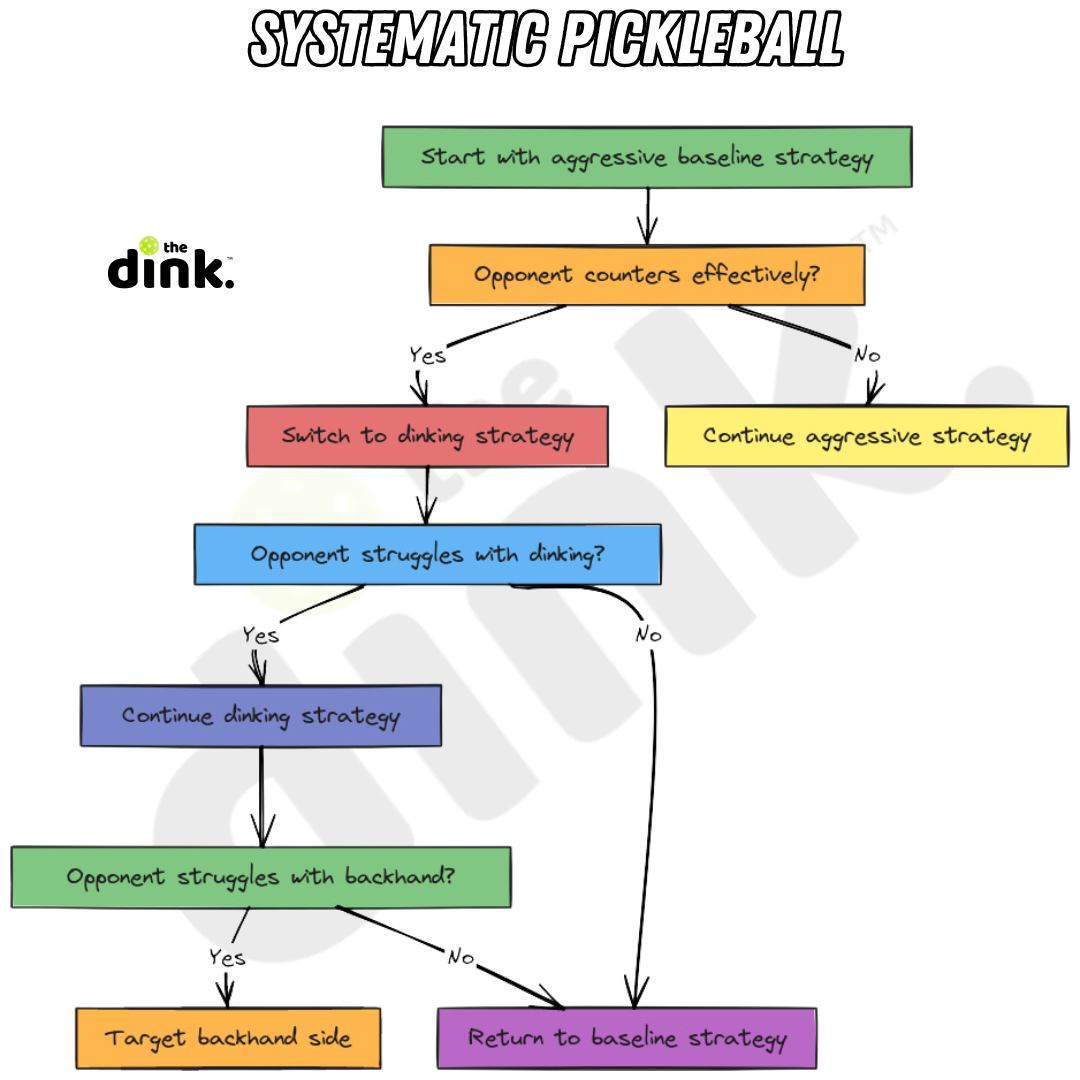
Pickleball is like chess.
5.0+ players are adept at pattern recognition, identifying and exploiting weaknesses, optimizing for strengths, and adjusting game plans based on their opponents' tendencies.
Power, athleticism, and fundamentals will only get you so far. Eventually, you need to learn to be cerebral. You need to learn to play chess.
Here are five strategies to help you do exactly that:
1. Adopt a Systematic Approach
In advanced pickleball, adaptability is key.
Imagine you're playing against an opponent who excels at baseline rallies.
You start with an aggressive baseline strategy, using powerful drives to keep them on the defensive. However, they begin countering effectively, returning your shots with ease. Recognizing this, you switch to a dink-focused game, emphasizing soft shots and placement. This change forces your opponent to move forward, disrupting their rhythm.
By having multiple strategies in your arsenal, you can maintain control of the match.
For instance, you might notice your opponent struggles with backhand shots. You can then adjust your strategy to target their backhand side, exploiting this weakness and gaining an advantage.
This systematic approach allows you to adapt dynamically, keeping your opponent off balance and enhancing your chances of success.

2. Expand Contact Point Capabilities
Handling shots from various positions is crucial for advanced players.
Consider a scenario where your opponent hits a fast, deep shot, forcing you to lunge backward. Instead of losing control, you've trained to hit effectively from this stretched position. You manage to return the ball with a precise lob, buying yourself time to recover.
Practicing shots while off-balance, such as lunging or reaching, improves your ability to maintain control during fast-paced exchanges. Engaging in hand battles at the net also sharpens your reflexes and paddle control.
For example, during a quick exchange at the net, you might find yourself jammed by a rapid shot. Your training allows you to adjust your paddle angle quickly, returning the shot with precision. By expanding your contact point capabilities, you increase your versatility and consistency on the court.
3. Neutralize Speedy Attacks
Neutralizing speedy attacks is a vital skill in advanced pickleball.
Imagine your opponent is executing powerful drives, putting you on the defensive. Instead of succumbing to the pressure, you masterfully use a soft block to absorb the pace and drop the ball into the kitchen. This forces your opponent to move forward, disrupting their aggressive play.
By focusing on drops, blocks, and resets, you can effectively neutralize your opponent's attacks.
For instance, during a high-speed volley exchange, you might use a reset shot to slow down the game, allowing you to regain control of the point.
This requires not only technical proficiency but also mental composure, as you must remain calm and focused under pressure.
Consistently neutralizing speedy attacks frustrates your opponent and forces them to adjust their strategy, giving you a strategic advantage.

4. Deceptive Speed Ups
Deceptive speed-ups are a powerful tool in advanced pickleball.
Picture a scenario where you're engaged in a dink exchange at the net.
Your opponent is expecting another soft shot, but you subtly change your grip and paddle angle, executing a quick speed-up down the line. Caught off guard, your opponent struggles to react in time, leading to an error.
The key to executing a successful speed-up is to disguise your intentions effectively. By using similar body mechanics and paddle positioning for both your dinks and speed-up shots, you keep your opponent guessing.
For example, you might notice your opponent is leaning forward during dink exchanges. You capitalize on this by suddenly accelerating your shot, catching them off balance.
By incorporating deceptive speed-ups into your game, you can enhance your offensive capabilities and gain a competitive edge.
5. Strategic Lobbing
Lobbing is a versatile strategy in advanced pickleball.
Imagine you're pinned at the baseline, with your opponent controlling the net. Instead of attempting a risky passing shot, you execute a high, deep lob over their head. Your opponent is forced to retreat, giving you time to move forward and regain control of the point.
Lobs can also be used offensively to catch opponents off guard during dink exchanges.
For instance, you notice your opponent is positioned too close to the net, leaning forward. You seize the opportunity to execute a surprise lob, sending the ball over their head and forcing them into an awkward position.
By practicing lobs with varying heights and depths, you enhance your ability to use them strategically.
Additionally, disguising your lobs makes them even more effective, as your opponent will have less time to react. Incorporating strategic lobbing into your game adds another dimension to your play, keeping your opponent guessing and enhancing your overall strategy.
If you like reading about pickleball strategy, you'll love The Dink Newsletter. It's the #1 read newsletter in pickleball...for a reason.










